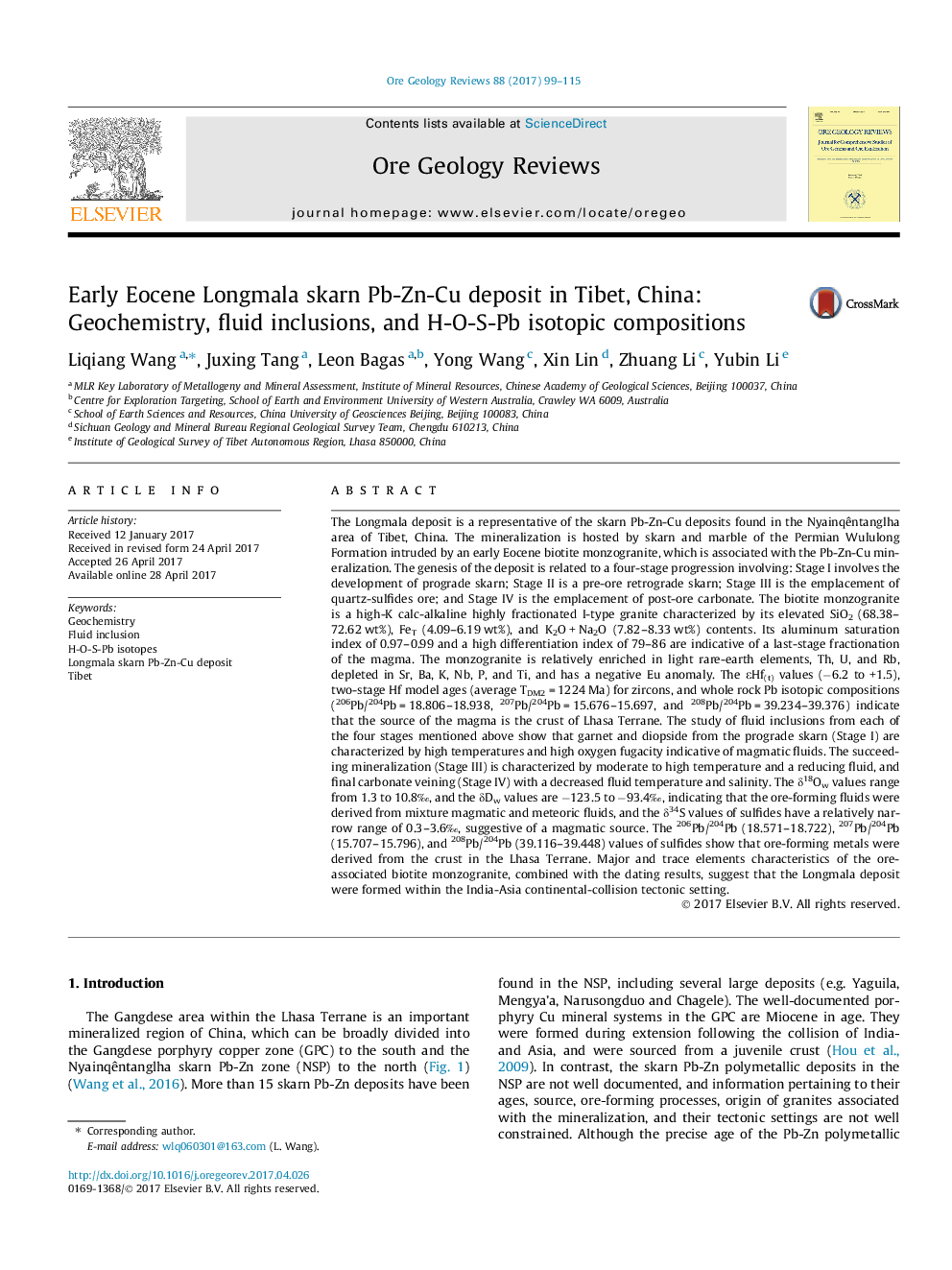| کد مقاله | کد نشریه | سال انتشار | مقاله انگلیسی | نسخه تمام متن |
|---|---|---|---|---|
| 5782322 | 1637219 | 2017 | 17 صفحه PDF | دانلود رایگان |

- The Longmala Pb-Zn-Cu deposit was formed within the India-Asia continental collision tectonic setting.
- The mineralization related biotite monzogranite is high-K calc-alkaline and highly fractionated I-type.
- Both the magma and ore-forming metals were derived from crustal materials of the Lhasa Terrane basement.
- Ore-forming fluids were sourced from magma with lots of meteoric water in the post-ore stage.
- Ore-forming fluids in pre-ore stage were high oxygen fugacity and transferred to reducing during the main-ore stage.
The Longmala deposit is a representative of the skarn Pb-Zn-Cu deposits found in the Nyainqêntanglha area of Tibet, China. The mineralization is hosted by skarn and marble of the Permian Wululong Formation intruded by an early Eocene biotite monzogranite, which is associated with the Pb-Zn-Cu mineralization. The genesis of the deposit is related to a four-stage progression involving: Stage I involves the development of prograde skarn; Stage II is a pre-ore retrograde skarn; Stage III is the emplacement of quartz-sulfides ore; and Stage IV is the emplacement of post-ore carbonate. The biotite monzogranite is a high-K calc-alkaline highly fractionated I-type granite characterized by its elevated SiO2 (68.38-72.62 wt%), FeT (4.09-6.19 wt%), and K2O + Na2O (7.82-8.33 wt%) contents. Its aluminum saturation index of 0.97-0.99 and a high differentiation index of 79-86 are indicative of a last-stage fractionation of the magma. The monzogranite is relatively enriched in light rare-earth elements, Th, U, and Rb, depleted in Sr, Ba, K, Nb, P, and Ti, and has a negative Eu anomaly. The εHf(t) values (â6.2 to +1.5), two-stage Hf model ages (average TDM2 = 1224 Ma) for zircons, and whole rock Pb isotopic compositions (206Pb/204Pb = 18.806-18.938, 207Pb/204Pb = 15.676-15.697, and 208Pb/204Pb = 39.234-39.376) indicate that the source of the magma is the crust of Lhasa Terrane. The study of fluid inclusions from each of the four stages mentioned above show that garnet and diopside from the prograde skarn (Stage I) are characterized by high temperatures and high oxygen fugacity indicative of magmatic fluids. The succeeding mineralization (Stage III) is characterized by moderate to high temperature and a reducing fluid, and final carbonate veining (Stage IV) with a decreased fluid temperature and salinity. The δ18Ow values range from 1.3 to 10.8â°, and the δDw values are â123.5 to â93.4â°, indicating that the ore-forming fluids were derived from mixture magmatic and meteoric fluids, and the δ34S values of sulfides have a relatively narrow range of 0.3-3.6â°, suggestive of a magmatic source. The 206Pb/204Pb (18.571-18.722), 207Pb/204Pb (15.707-15.796), and 208Pb/204Pb (39.116-39.448) values of sulfides show that ore-forming metals were derived from the crust in the Lhasa Terrane. Major and trace elements characteristics of the ore-associated biotite monzogranite, combined with the dating results, suggest that the Longmala deposit were formed within the India-Asia continental-collision tectonic setting.
152
Journal: Ore Geology Reviews - Volume 88, August 2017, Pages 99-115